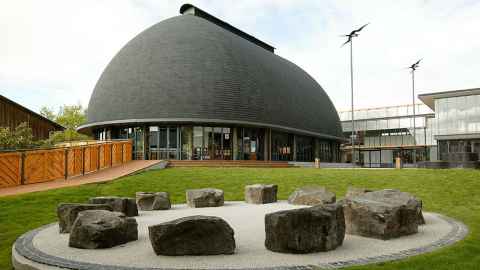Enacting alofa between NZ and Samoa
1 June 2018
Opinion: Vaiaso o Le Gagana Sāmoa – Samoan Language Week – finishes tomorrow. This year’s theme was ‘Alofa atu nei, alofa mai taeao’: ‘Kindness received, kindness given’, or literally, “Give love now; receive love tomorrow”.

This theme or proverb articulates in practice the Samoan cultural value of reciprocity which continues to be enacted in Samoan families and communities today. It provides a lens into Samoan culture that demonstrates the privileging of relationships. People in relationships hold the rights, responsibilities, and expectations of being in relationship with one another. In viewing the world through a Samoan lens, an underpinning principle of relationship is reciprocity, expressed in colloquial terms as “I’ve got your back and you’ve got mine”, or as James Taylor sang in the 70s, ‘You just call out my name, and you know wherever I am, I’ll come running... Winter, spring, summer or fall, all you have to do is call, and I’ll be there…”
Actually Samoans don’t call, they expect you to be there if you are committed to the relationship. In return, they will be there, without fail, when you need them, enacting alofa in tangible and practical ways.
So is there a bigger lens that we might apply to this idea of reciprocal two-way relationships than simply individual to individual, or family to family, or village to village? What if we were to extend our lens further, and consider the relationship between Aotearoa New Zealand and the nation of Samoa? To do this, we need to know and understand the origins and whakapapa of our familial, historical and constitutional relationship in order to understand the reciprocal responsibilities of that relationship in the present day.
Tangata whenua (people of the land) are the indigenous first peoples of this land of Aotearoa. All New Zealanders have a constitutional responsibility to acknowledge and promote systemically the position of tangata whenua as the indigenous first peoples of the land. As Pacific peoples we also recognise the whānau relationships in whakapapa that connect ‘tangata whenua’ (people of the land), to ‘tagata o le moana’ (people of the sea, the Pacific Ocean).
At my Samoan sister-in-law’s tangi this week at Te Puea Marae, the kai korero (hosting orator) from Tainui spoke about the ancient connection between the peoples of Tainui and the peoples of Savaii, Samoa. In te reo Māori we have a whakatauki that states, ‘E kore au e ngaro, he kakano i ruia mai i Rangiātea’ – ‘I will never be lost, for I am a seed sown in Rangiātea’. Where is Rangiatea? In the words of novelist and social anthropologist Epeli Hau’ofa, it is in ‘our sea of islands’: the Pacific. It is Rangiatea – Raiatea – Hawaiki – Hawaii – Savaii, and other locations that our ancient waka sailed from. We are the Polynesian whanau of the Indigenous Peoples of the Pacific.
Actually Samoans don’t call, they expect you to be there if you are committed to the relationship. In return, they will be there, without fail, when you need them, enacting alofa in tangible and practical ways.
A few weeks ago the university notice about the Anzac Day remembrance service began with the following words: “While Britain’s failed campaign at Gallipoli stands foremost in the Anzac memory, we remember New Zealanders’ contributions beginning with the capturing of Samoa from Germany in 1914.”
Why is it not appropriate to celebrate New Zealand’s contribution through the ‘capturing’ of Samoa in 1914? Because the occupation and administration of Samoa by New Zealand’s colonial government from 1914 to1962 marks a disastrous time in Samoan history. It began with Robert Logan’s paternalistic and inept administration in 1914; the decimating of the population in the 1918 influenza pandemic, and the death of the prominent Samoan leader Tupua Tamasese Lealofi III and others on Black Saturday, December 28 in 1929 during the Mau Movement’s peaceful demonstration through the streets of Apia.
We need to know our relational past in order to enact our reciprocal present, because the historical and constitutional position of Samoans within Aotearoa NZ today is a result of NZ’s occupation and administration of Samoa from 1914 to 1962. To couch it in such terms without thinking of those who were affected by “New Zealanders’… capturing of Samoa” (there was no resistance by the German administration) seems inappropriate and insensitive to say the least. For more information on our shared history, see here.
In the 1950s and 60s we saw New Zealand’s gaze turn once again to the Pacific, as its manual labour shortage precipitated a new wave of workforce migration. Many of us are here as second or third generation New Zealanders because our parents or grandparents sacrificed much to give their families what was considered a ‘better life’.
What does all of this mean for us today? Tangata whenua are not only the indigenous people of the land, they also belong to tagata o le moana. All New Zealand educators should understand that universities and schools need to address not only equity considerations for Samoans and other Pasifika peoples, but also position them in their rightful place, as indigenous peoples of the Pacific, wider whanau of tangata whenua, and current partners in a reciprocal relationship with the government and peoples of Aotearoa New Zealand.
As a result of this reciprocal partnership, I also believe that New Zealand has a constitutional responsibility to the maintenance and revitalisation of gagana Samoa and other Pacific languages that goes beyond a ‘one week a year’ approach.
Dr Rae Si’ilata is Associate Dean of Pasifika at the University of Auckland’s Faculty of Education and Social Work.
This article reflects the opinion of the author and not the views of the University of Auckland.
Reproduced with permission from Newsroom, Enacting alofa between NZ and Samoa published on Friday 1 June 2018.